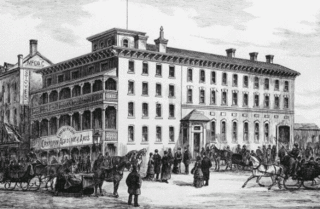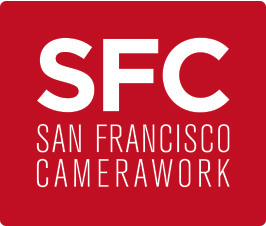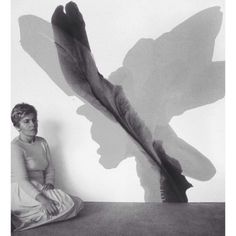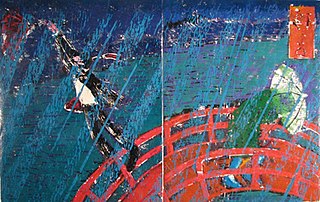Related Research Articles

The Royal Canadian Academy of Arts (RCA) is a Canadian arts-related organization that was founded in 1880.

Gronk is the pseudonym of Chicano painter, printmaker, and performance artist Glugio Nicandro. His work is collected by museums around the country including the Smithsonian American Art Museum.
Diane Gamboa has been producing, exhibiting and curating visual art in Southern California since the 1980s. She has also been involved art education, ranging from after-school programs to college and university teaching. Gamboa has been "one of the most active cultural producers in the Chicana art movement in Los Angeles." She actively developed the Chicano School of Painting.

Marina DeBris is the name used by an Australian-based artist whose work focuses on reusing trash to raise awareness of ocean and beach pollution. DeBris uses trash washed up from the beach to create trashion, 'fish tanks', decorative art and other works of art. She has also used beach trash to provide one perspective on what the earth might look like from space. As well as creating art from debris, DeBris also is a fund raiser for environmental organizations, and collaborates with non-profit organizations and schools to educate children about ocean pollution. In 2021, DeBris found almost 300 face masks on beaches, and used them in her trashion and other displays.
Mario Reyes Castillo (1926–2017) was a Mexican printmaker, painter and sculptor best known for his work with the Taller Libre de Grabado Mario Reyes, which he founded in 1965. This workshop has collaborated with and done work for a number of notable Mexican artists. Much of his artwork was dominated with depictions of the female form, with the artist stating he could see it in many places and objects. His work has been recognized with tributes and retrospectives in places such as the Museo Nacional de Estampa and the Palacio de Bellas Artes. He was also a member of the Salón de la Plástica Mexicana.

SF Camerawork is a non-profit art gallery in San Francisco, California dedicated to new ideas and directions in photography.

Sheila Pinkel is an American visual artist, activist and educator whose practice includes experimental light studies, photography, conceptual and graphic works, and public art. She first gained notice for cameraless photography begun in the 1970s that used light-sensitive emulsions and technologies to explore form; her later, socially conscious art combines research, data visualization, and documentary photography, making critical and ethical inquiries into the military-industrial complex and nuclear industry, consumption and incarceration patterns, and the effects of war on survivors, among other subjects. Writers identify an attempt to reveal the unseen—in nature and in culture—as a common thread in her work.
Kim Anno is a Japanese-American abstract painter. Born in Los Angeles, California to Japanese-Polish and Native American-Irish parents, respectively, she studied at San Francisco State University, earning a Bachelor of Fine Arts in 1982. She was awarded a Master of Fine Arts degree in 1985 from the San Francisco Art Institute. Anno began working at the California College of the Arts in 1996 as an associate professor, and was chair of the painting department as of 2012.
Jo Hanson (1918–2007) was an American environmental artist and activist. She lived in San Francisco, California. She was known for using urban trash to create works of art.

Irene Monat Stern (1932-2010) was a American artist who spent her working life in the United States. Known for her abstract paintings, her works have been displayed and collected across the United States; from The Esther-Robles Gallery in Los Angeles, to the Metropolitan Museum of Art in New York, to the Hirshhorn Museum and Sculpture Garden in Washington D.C.'s permanent collection.
Ana Teresa Fernández is a Mexican performance artist and painter. She was born in Tampico, Tamaulipas, and currently lives and works in San Francisco. Fernández attended the San Francisco Art Institute, where she earned bachelor's and master's of fine arts degrees. Fernández's pieces focus on "psychological, physical and sociopolitical" themes while analyzing "gender, race, and class" through her artwork.

M. Louise Stanley is an American painter known for irreverent figurative work that combines myth and allegory, satire, autobiography, and social commentary. Writers such as curator Renny Pritikin situate her early-1970s work at the forefront of the "small, but potent" Bad Painting movement, so named for its "disregard for the niceties of conventional figurative painting." Stanley's paintings frequently focus on romantic fantasies and conflicts, social manners and taboos, gender politics, and lampoons of classical myths, portrayed through stylized figures, expressive color, frenetic compositions and slapstick humor. Art historians such as Whitney Chadwick place Stanley within a Bay Area narrative tradition that blended eclectic sources and personal styles in revolt against mid-century modernism; her work includes a feminist critique of contemporary life and art springing from personal experience and her early membership in the Women's Movement. Stanley has been awarded a Guggenheim Fellowship and grants from the Pollock-Krasner Foundation, Adolph and Esther Gottlieb Foundation, and National Endowment for the Arts. Her work has been shown at institutions including PS1, San Francisco Museum of Modern Art (SFMOMA), The New Museum and Long Beach Museum of Art, and belongs to public collections including SFMOMA, San Jose Museum of Art, Oakland Museum, and de Saisset Museum. Stanley lives and works in Emeryville, California.

Robert Brokl is an American visual artist and activist based in the Bay Area, known for expressive woodblock printmaking and painting that has focused on the figure, landscape and travel for subject matter. His visual language combines the influences of German Expressionism, Japanese woodblock printing and the Bay Area Figurative Movement with a loosely autobiographical, Romantic interest in representing authentic personal experience, inner states and nature. Critics and curators characterize his style by its graphic line, expressive gestural brushwork, tactile surfaces and sensitivity to color, mood and light.
Jan Rindfleisch is an American artist, educator, author, curator, and community builder. Rindfleisch is known for the programming she initiated and oversaw at the Euphrat Museum of Art; for her book on the history of art communities in the South Bay Area, Roots and Offshoots: Silicon Valley's Art Community, and for her role in documenting the careers and legacies of Agnes Pelton and Ruth Tunstall Grant.
The Sanchez Art Center is a nonprofit arts organization located in Pacifica, California. It was formed in 1996 by local artists and community members.
Judith Selby Lang is an American artist and environmental activist working with found beach plastic. Selby Lang is known for sourcing beach plastic from a single site: 1000 yards of Kehoe Beach along the Point Reyes National Seashore in Northern California, and then turning that plastic into artworks. Selby Lang works both independently and with her partner Richard Lang.

Barbara Nancy Brash was a twentieth-century post-war Australian artist known for her painting and innovative printmaking. In an extensive career she contributed to the Melbourne Modernist art scene, beside other significant women artists including: Mary Macqueen, Dorothy Braund, Anne Marie Graham, Constance Stokes, Anne Montgomery (artist) and Nancy Grant.

Winston Swift Boyer is an American fine art photographer living in Carmel-by-the-Sea, California, and is best known for his color photography of landscapes in the United States and Europe. Since the late 1970s, Boyer's photography has engaged a wide variety of subject matter, including landscapes, architecture, portraits, and still-lifes. Boyer's first gallery exhibition was in 1979. He has exhibited in Paris, Canada, New York City, Massachusetts, and California. His work is included in permanent collections in the United States, including the Crocker Art Museum, Brooklyn Museum and the Art Institute of Chicago. Boyer is the author of American Roads, published by Little, Brown and Company, Bullfinch Press, a photographic chronicle of driving tours through the United States.
Raheleh "Minoosh" Zomorodinia is an Iranian-born American interdisciplinary visual artist, curator, and educator. She works in many mediums, including in photography, video, installation, and performance. Her work is informed by the tension between Iran and the United States, as well as explorations of the self, of home, nature, and the environment. She is based in the San Francisco Bay Area.

Gary Hugh Brown is an American artist, painter, draftsman, and Professor Emeritus of Art at the University of California, Santa Barbara. His work is included in permanent collections in the United States, including the Santa Barbara Museum of Art and the Art, Design & Architecture Museum. He has had over thirty-five one-person shows and has participated in 200 group exhibitions in Japan, Ireland, Brazil, and the United States.
References
- ↑ "About Gallery Route One". GALLERY ROUTE ONE. Retrieved 2022-06-11.
- ↑ "Tomales Students Share Art in Gallery Route One Exhibit | Pacific Sun". Pacific Sun | Marin County, California. 2021-05-03. Retrieved 2022-06-11.
- ↑ "Latino Photography Project holds Point Reyes show". Marin Independent Journal. 2012-03-08. Retrieved 2022-06-11.
- ↑ Palczynski, Verenice. "Latino Photography Project at Gallery Route One". Redwood Bark. Retrieved 2022-06-11.
- ↑ Kimmey, Samantha (2013-05-09). "Latino photo project captures palates". Point Reyes Light. Retrieved 2022-06-11.
- ↑ "Gallery Route One's Artists In The Schools". Roadtrippers. Retrieved 2022-06-11.
- ↑ Bragdon, Phyllis (August 23, 1985) [August 23, 1985]. "Contemporary Painters from Hungary". Westart. 23 (23): 3 – via Internet Archive.
- ↑ "Hungarian Art Comes to the U.S." People's World. 48 (33): 10. August 17, 1985 – via Internet Archive.
- ↑ D'Souza, Ajay. "Gallery Route One". Sparsely Sage and Timely. Retrieved 2022-06-11.
- 1 2 Morris, Barbara (July 2001). "Disposable Truths". Artweek. 32 (7): 20.
- ↑ "Eco Echo Art Exhibitions". preneo.org. Retrieved 2022-06-22.
- ↑ "California Society of Printmakers". Extraction: Art on the Edge of the Abyss. Retrieved 2022-06-11.
- ↑ "2021 Exhibitions: Searching for Meaning @ GRO – California Society of Printmakers" . Retrieved 2022-06-11.
- ↑ Morris, Barbara (December 2002). "'Turnging the Tables' at Gallery Route One". Artweek. 33 (10): 17.
- ↑ "GALLERY ROUTE ONE". GALLERY ROUTE ONE. Retrieved 2022-06-12.